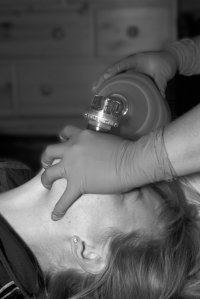Comparison of Bag-Valve-Mask Hand-Sealing Techniques in a Simulated Model
Annals of Emergency Medicine. Volume 63, Issue 1 , Pages 6-12.e3, January 2014
Bag-valve-mask ventilation remains an essential component of airway management. Rescuers continue to use both traditional 1- or 2-handed mask-face sealing techniques, as well as a newer modified 2-handed technique. We compare the efficacy of 1-handed, 2-handed, and modified 2-handed bag-valve-mask technique.
Methods
In this prospective, crossover study, health care providers performed 1-handed, 2-handed, and modified 2-handed bag-valve-mask ventilation on a standardized ventilation model. Subjects performed each technique for 5 minutes, with 3 minutes’ rest between techniques. The primary outcome was expired tidal volume, defined as percentage of total possible expired tidal volume during a 5-minute bout. A specialised inline monitor measured expired tidal volume. The authors compared 2-handed versus modified 2-handed and 2-handed versus 1-handed techniques.
Results
The authors enrolled 52 subjects: 28 (54%) men, 32 (62%) with greater than or equal to 5 actual emergency bag-valve-mask situations. Median expired tidal volume percentage for 1-handed technique was 31%; for 2-handed technique, 85%; and for modified 2-handed technique, 85%. Both 2-handed and modified 2-handed technique resulted in significantly higher median expired tidal volume percentages compared with 1-handed technique. The median expired tidal volume percentages between 2-handed and modified 2-handed techniques did not significantly differ from each other.
Conclusion
In a simulated model, both 2-handed mask-face sealing techniques resulted in higher ventilatory tidal volumes than 1-handed technique. Tidal volumes from 2-handed and modified 2-handed techniques did not differ. Rescuers should perform bag-valve-mask ventilation with 2-handed techniques.

